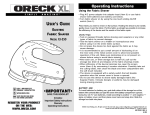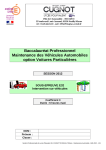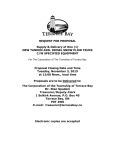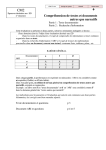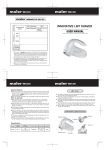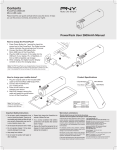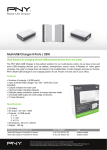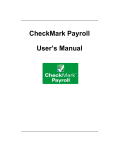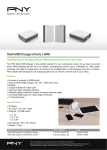Download Car Operation & Maintenance - Philippe Boursin
Transcript
First Name : Name : Car Operation and Maintenance Business & Technician Education Council level A P. Boursin LPo N-J Cugnot 93 Neuilly/Marne Car Operation & Maintenance option: Light Vehicle SHOPWORK and SHOP MANUALS 3-1 The six steps in automotive service Servicing jobs vary from simple to difficult. But no job requires more than six steps. These are: 1. Measuring 2. Disassembling 3. Machining 4. Installing new or serviced parts 5. Reassembling 6. Adjusting Some jobs require fewer steps. Let's look at these six basic steps. They are performed by using hand tools, measuring tools, and power tools. Tools and their uses are described in following chapters. Note There is a difference between "reinstall" and "replace." When you reinstall a part or component you are putting back the same part or component that you removed. But when you replace a part or component you have discarded the old part or component and are install a new one. These are the definitions used in the automotiveservice business and in this book 1. Measuring Before you can work on a car, you must find out what is wrong with it. You often begin by measuring (Fig. 3-1). Linear measurements are the most common kind of measurement. They are measurements you take in a straight line. For example, you might measure an opening or a diameter. Using the familiar United States Customary System (USCS), you take measurements in inches or fractions of an inch. Using the metric system, you take measurements in millimeters, centimeters, or meters. Ail imported and many domestic vehicles are measured with the metric system. Chapter 4 describes the USC and metric systems. There are other ways to measure. Sometimes the measuring is done by listening - as when you listen to a running engine. When you check the oil in an engine, you measure its level in the crankcase. You use test instruments to measure battery conditions. When you check engine vacuum or compression, you measure engine performance. The results of your measurements tell you what sort of job you have to do. Fig. 3-1 Measuring the diameter of an engine cylinder with a steel rule. (ATW) Lycée polyvalent - Section professionnelle N.J.CUGNOT NEUILLY/Marne 1 First Name : Name : Car Operation and Maintenance Business & Technician Education Council level A P. Boursin LPo N-J Cugnot 93 Neuilly/Marne Car Operation & Maintenance option: Light Vehicle 2. Disassembling Sometimes the measurements show that there is trouble. You then have to disassemble, or "take apart," the component to get at the trouble. Suppose your measurements show that the valves are not doing their job. You then have to take some parts of the engine off, to get to the valves and repair them (Fig. 3-2). Disassembly is also called tear down. For example, you disassemble, or tear down, an engine. However, you do it carefully, part by part. Fig. 3-2 Cylindre head from a V-8 engine, showing the valves for one cylindre removed. (Chevrolet Motor Division of General Motor Corporation) 3. Machining Sometimes you have to remove metal from a part. Using a machine to remove metal is called machining. Suppose you find valve trouble. This could require machining, or "grinding," the valves and valve seats. Or you might find that the engine cylinders require machining. Special machines are required to do these jobs. 4. Installing New Parts You might find that some parts are so worn that they must be thrown away. Then new parts must be installed in their place. For example, engine bearings sometimes wear out, and new ones must be installed in place of the old ones. Even new parts may require machining to make them fit. 5. Reassembling After a repair, you may have to put some parts back together. This is called reassembly. You put the parts back together to make a complete assembly. 6. Adjusting As an automobile is operated, parts formally wear. This requires adjustments from time to time. Also, adjustments may be required after a service job. For example, after grinding the valves, you put everything back together. Then you measure the valve action. If it is not right, adjustments must be made. 3-2 Specifications You will hear the word "specifications," or "specs," quite often if your shopwork. The specs give you the right measurements for the cars you work on. The car manufacturer sets the specs. You find the specs if the manufacturer's shop manual. These specs include valve setting, ignition timing, piston clearances, piston-ring clearances, and hundreds of other measurements. These terms are explained if later chapters. Lycée polyvalent - Section professionnelle N.J.CUGNOT NEUILLY/Marne 2 First Name : Name : Car Operation and Maintenance Business & Technician Education Council level A P. Boursin LPo N-J Cugnot 93 Neuilly/Marne Car Operation & Maintenance option: Light Vehicle 3-3 Manufacturer's service manuals Each year, every car manufacturer issues a service manual covering the cars manufactured that year (Fig. 3-3). Each manual covers all service procedures, provides the specs, names the tools needed, and explains how to do all service jobs on the car models produced that year. Fig. 3-3 Manufacturers' service manuals supply detailed servicing information on their latest models. (ATW) You should take a careful look at any manufacturer's service manual you get your hands on. Note how it is arranged in groups or sections. Figure 3-4 shows the section index for a recent Chevrolet service manual. Each section is further divided into descriptions of specific components. These explain how to fond and repair troubles with those components, and list the special tools required to service them. Get acquainted with car manufacturers' service manuals. You will be using them when you work in the shop. Practice using these manuals. Look up "Engine," "Transmission," and 50 on in a manual. Note how each section is divided into specific service jobs. 3-4 Flat rate Two ways that automotive mechanics are paid are by fixed income and by flat rate (or "piecework"). With a fixed income, the mechanic is paid so much per hour or per week. When the pay is by flat rate, the mechanic earns so much per job. Fiat rate tells the number of hours and minutes it normally takes to do a service job. Car makers and independent companies print flat-rate manuals. These are also called time-labor standards. They list every service job and the amount of time it takes to do the job. For example, one flat-rate manual says that it takes 10 hours to install new piston rings in a certain engine. If the labour charge is $3000 per hour, the total labour charge for the job is $30000. Many shops divide the labour charge with the mechanic. With the right tools, the mechanic can often do service jobs in less than the flat-rate time. Suppose a mechanic does a 10-hour job in 8 hours, for example. The mechanic would still get paid for 10 hours even though the job actually took less time. 3-5 Other useful publications Many automotive-service magazines are published. They contain information on servicing cars and articles on specific service jobs. They often have tips on how to make hard jobs a little easier. Testing-equipment manufacturers, parts makers, and tool and service-equipment manufacturers publish manuals on how to install their parts or use their equipment. These publications can be very helpful. Lycée polyvalent - Section professionnelle N.J.CUGNOT NEUILLY/Marne 3 First Name : Name : Car Operation and Maintenance Business & Technician Education Council level A P. Boursin LPo N-J Cugnot 93 Neuilly/Marne Car Operation & Maintenance option: Light Vehicle Fig. 3-4 Section index tram a recent Chevrolet service manual Lycée polyvalent - Section professionnelle N.J.CUGNOT NEUILLY/Marne 4 First Name : Name : Car Operation and Maintenance Business & Technician Education Council level A P. Boursin LPo N-J Cugnot 93 Neuilly/Marne Car Operation & Maintenance option: Light Vehicle 3-6 Paperwork You cannot run any kind of business without paperwork, and the automotive-service business is no exception. From the time that a car drives in for service, until the time that the bill for service is paid, there is paperwork to be done. Actually, paperwork begins well before the car arrives. Let's see how it works. 1. The Parts Department The parts department has to have on hand ail fast-moving parts that might be needed to service cars. These parts include spark plugs, fan belts, anti-freeze, engine oil, brake fluid, distributor contact points, ignition coils, gaskets, and screws and bolts. Ail these parts and supplies have to be ordered by the parts manager. The parts manager writes out orders for the things needed to stock the department. The parts manager also has to keep a record, or inventory, of the parts in stock. That way, more parts or supplies can be ordered when the inventory runs low. Ail this record keeping and ordering is paperwork. 2. The Service Department The phone rings and the service manager or an assistant answers. Someone has car trouble. The caller wants to bring a car in for service. The service manager consults the work schedule (often called the dispatch sheet), and tells the caller that the department can handle the car at ten the next morning. The service manager notes this down on the schedule. When the car arrives the next morning, it is met by the service manager or a service-order writer, who is usually called a service writer or a service advisor. The driver explains the problem. The service writer writes the customer complaint on the repair order, together with labor instructions and notes to the mechanic. The repair order accompanies the car as it is "dispatched" or sent to the mechanic assigned to do the service job. The mechanic follows the labor instructions on the repair order, doing whatever is necessary to repair the car. If new parts are needed, the mechanic gets them from the parts department. To get parts from some parts departments, the mechanic presents the mechanic's copy of the repair order to the parts counter attendant. The attendant issues the parts and writes the price of each part on the repair order. When the job is completed, the service writer or service manager writes, on the repair order, the flat-rate time or the time taken by the mechanic to do the job. To pick up the car, the customer pays the price of the parts, plus the price of the mechanic's labor charge, and any taxes required by haw. 3. Billing Everything is added up on the service order to get the total cost of the repair. If the job is to be paid for in cash, the driver pays the bill when taking delivery of the car. If credit has been established, the car owner is sent a bill which should be paid after 50 many days. Even here the paperwork does not end. When the payment comes in, it has to be credited against the car owner's account. And, if the car owner is show to pay, letters have to go out asking for payment. If the car owner refuses to pay, it may be necessary to take legal action. All this is paperwork. 4. Other Paperwork The owner or manager of an automotive-service business also keeps books of various kinds. These include periodic P&L (profit and loss) statements, employee records, general inventories, and local, state, and federal tax records. You now have a brief review of the paperwork involved in the automotive-service business. Whatever type of job you take in the business will involve some paperwork. You will learn exactly how to handle your paperwork when you go out into the shop. Automotive Mechanics, Crosse/Angolan, Gregg Division, McGraw-Hill Book Company, 1984 source http://philippe.boursin.perso.sfr.fr/europe\dnl01.htm Lycée polyvalent - Section professionnelle N.J.CUGNOT NEUILLY/Marne 5 First Name : Name : Car Operation and Maintenance Business & Technician Education Council level A P. Boursin LPo N-J Cugnot 93 Neuilly/Marne Car Operation & Maintenance option: Light Vehicle Review Questions Select the one correct, best, or most probable answer to each question. You can find the answers in the section indicated at the end of each question. 1. The six steps in automotive service include (3-1) a. measuring and disassembling b. machining and installing new parts c. reassembling and adjusting d. all of the above 2. To "reinstall" means to (3-1) a. repair a disassembled part b. put back a component or part you have removed c. reassemble a component d. remove and replace a part 3. In shop talk, to "replace" means to (3-1) a. put back a part that was removed b. discard the old part and install a new one c. reassemble a component d. readjust a part that has been replaced 4. Tools used in the shop include (3-1) a. hand tools and powers tools b. measuring tools and cutting tools c. hand tools and cutting tools d. all of the above 5. Fiat rate is (3-4) a. the rate in dollars required to do a job b. the speed with which you can do a job when working flat out c. the time it normally takes to do a service job d. all of the above Lycée polyvalent - Section professionnelle N.J.CUGNOT NEUILLY/Marne 6







